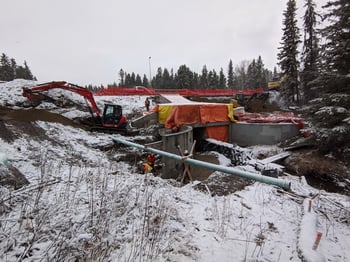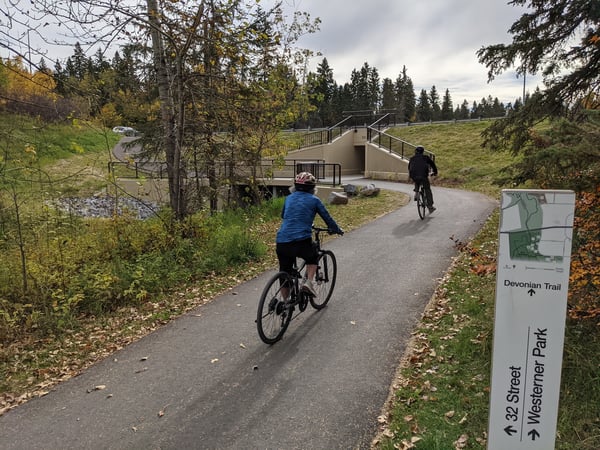More Than "Just a Structural Rehab".
32nd Street / Piper Creek Active Transportation Underpass and Major Culvert Rehabilitation, Red Deer, Alberta
The structural integrity of the 32nd Street/ Piper Creek Active Transportation Underpass in the City of Red Deer has been drastically improved. This complex structural rehabilitation has also greatly enhanced the overall experience of Devonian Trail users in the urban forest of Piper Creek Ravine through significant functional and aesthetic improvements. Construction challenges such as emergent structural deficiencies, steep embankments, a fish-bearing creek, and traffic on the trail and roadway were met with strong engineering solutions, effective construction staging and a committed, collaborative team. The appealing and safe rehabilitated structure now reflects the surrounding natural landscape and accommodates the anticipated future growth of the City’s Active Transportation Network.

EXTENDING A STRUCTURE’S LIFE WHILE IMPROVING FUNCTION AND FIT.
Originally built in 1962, the unique 50 metre long, buried, reinforced concrete box culvert is comprised of three rectangular boxes. Two lower boxes convey a fish bearing creek, and an upper box centered over the west creek cell accommodates pedestrians, cyclists and other trail users. Sloped retaining walls frame the underpass portal, and tall curved retaining walls on independent shallow footings frame the creek inlet and outlet.
Major rehabilitation was needed to address life cycle durability issues, structural and functional deficiencies, such as large lateral movements and damage to the tall, curved retaining walls, deterioration of reinforced concrete walls and slabs, restricted sightlines and trail congestion. Improving safety and the overall aesthetic of the structure were important considerations.
ROBUST, INNOVATIVE AND DURABLE SOLUTION
Morrison Hershfield led an interdisciplinary team through the condition assessment, preliminary design, detailed design, and contract administration stages of the project. The successful rehabilitation showcases the highly coordinated and intense collaboration between structural, civil, transportation, geotechnical, environmental and landscape architecture specialists.
Highlights of the many complex and innovative elements of this project include:
- Pedestrian Tunnel Portal Side-Wall Bracing: Rather than removing and replacing the walls (requiring large excavations and temporary stabilization of the road) or thickening the walls (reducing useful tunnel width), steel pipe struts with a similar aesthetic to the new railings were installed across the top of the South underpass portal. This reduced costs without detracting from the overall appearance.
- Benched Slope with competent granular backfill improves slope stability and soil retention.
- Lower Retaining Wall Stabilization by Post-Tensioned Grouted Soil Anchors and Self-Consolidated Concrete (SCC) Refacing: Three of the four curved lower walls were strengthened rather than replaced. Soil anchors and refacing avoided the need for replacement, saving money and reducing geotechnical risk of destabilizing the roadway embankment.
- Specialized Construction Methodology for Soil Anchors: To suit the tight fit, soil anchors were first installed by lateral drilling using an excavator mounted auger positioned above each wall. Then, the high-strength threaded rod anchor was immediately placed within the excavated hole and tremie-grouted. Following a curing period, anchors were tensioned. A load testing program was completed to ensure long term performance and function of the anchors.
- Curved Wall Replacement @ NE Lower Creek Wall: One of the four lower retaining walls was replaced due to a severe structural crack, and separation from the box culvert outlet. To avoid very large excavations or extensive temporary stabilization of the 32nd Street embankment, the existing fractured vertical wall was fully removed, and a new reinforced concrete wall was cast onto the existing spread footing, duplicating the signature curved appearance of pre-existing walls.
- Trail Tunnel Opening and New Flared Retaining Walls: To improve sightlines at tunnel portal openings and reduce pedestrian and cyclist conflicts, existing retaining walls were cut back and new “flared” and sloping retaining walls protect the 32nd Street embankment slopes.
- Enhanced Look and Feel: Textured form liner, landscaped planting beds, and pigmented sealer in a “historic tan” colour reduce the visual impact of the walls on the natural landscape. New railings, provided for over 90% of the project, were designed to be transparent and safe.
- Load Restrictions and Congested Resurfacing: The weight of micro-milling equipment was strictly limited, and removal depths carefully controlled during careful micro-milling and resurfacing of the tunnel floor slab/waterway culvert roof slab with a fibre-reinforced concrete overlay.
- Traffic Management: Impacts on pedestrian and vehicle traffic were minimized. Single lane closures to 32nd Street were only permitted during off-peak hours, and the Devonian Trail remained accessible throughout construction, with a detour around the site.
- Piper Creek Protection and Enhancement: Maintaining the integrity of the fish-bearing watercourse throughout construction was critical. Work was scheduled outside the Restricted Activity Period and federal and provincial requirements were strictly adhered to. The watercourse was isolated half-and-half (east side and then west side) and sediment monitoring was performed during any change in stream isolation to ensure no damage to fish. In addition, a short “fish block” was cast at the upstream end of one of the two culvert cells. This directs stream flow into one culvert cell during periods of low water, raising the water level in that cell facilitating fish passage.

MANAGING RISK
With any project, there is a possibility of unexpected events. Managing the impacts of those risks on schedule, quality, cost, the environment and the public is paramount.
During this rehabilitation, risk management began early during concept development and continued through detailed design and construction. Factors taken into consideration included conceptual construction staging, geotechnical stability, environmental risks, and impacts to pedestrian and vehicle traffic. Clear special provision performance requirements were provided to the Contractor to allow flexibility in the methods and sequencing of work while still meeting all regulatory and City requirements.

Despite best efforts, unexpected events did occur. However, the team was prepared and well-equipped to respond. For example, during construction, the northeast retaining wall fractured, requiring rapid intervention. The team proposed, analyzed and detailed a sub-footing to “bridge” the large crack uncovered in the existing concrete footing within 24 hours. This allowed construction to proceed with minimal delay.
The project also faced a significant construction delay due largely to construction supply and resourcing challenges. To minimize the impact of the delay, key strategies like robust record keeping, increased full-time site resources and collaborative tri-party problem solving were employed to reduce impacts and bring the project to successful conclusion.
ENVIRONMENTAL AND SOCIAL BENEFITS
- Structural rehabilitation has a smaller construction footprint than a complete replacement project. Relatively speaking, this project resulted in limited site disturbance.
- Strengthening the progressively failing retaining walls and improving slope stability at the site has reduced the risk of future wall or slope failures impacting the riparian environment.
- Upgraded armoring and naturalized bank erosion protection (such as willow whips) has reduced the potential impacts of future flooding at the site.
- Site restoration involved revegetating the site with native vegetation species.
- Rehabilitation and rejuvenation of this link in the City of Red Deer’s Active Transportation Network ensures the continued operation of the multimodal crossing for years to come.
- Functional and aesthetic improvements for trail users improves the overall experience by enhancing safety and overall fit of the structure into the natural landscape.

WANT TO KNOW MORE?
To learn more about this project, visit the Morrison Hershfield booth at the upcoming Short Medium Span Bridge (SMSB) Conference in Toronto from July 19 to 22, 2022.
Posts by Topic
Topics
- 5G (1)
- ACEC (3)
- Active Transportation (5)
- AFP/P3 (6)
- Alberta (5)
- Anniversary (1)
- approvals (1)
- Architect (2)
- Atlanta (2)
- Awards (62)
- Biophysical Sciences (1)
- Board of Directors (1)
- Bridge Rehabilitation (3)
- Building and Facilities Engineering (2)
- Building Energy (25)
- Building Envelope (48)
- Building Science (65)
- Calgary (2)
- Canada 150 (1)
- Canstruction (2)
- Capabilities (1)
- Carbon emissions (2)
- Carbon Pathfinder Tool (1)
- Carson Awards (5)
- Charity (13)
- Climate Adaption (7)
- climate change (7)
- Code and Life Safety (8)
- Commercial Buildings (4)
- Commissioning (11)
- Construction (2)
- Construction Administration (5)
- Consulting Engineering (1)
- Critical Facilities (33)
- CSR (24)
- Culture (5)
- Dallas (1)
- Data Center (22)
- Data Center Commissioning (9)
- Data Center Design (12)
- design (9)
- Design Build (1)
- DSSP (1)
- edgecomputing (1)
- edgetechnologies (1)
- Edmonton (4)
- Electrical (24)
- Electrical engineering (8)
- Energy (8)
- Engineers Canada (5)
- Environmental (36)
- Environmental Compensation (1)
- Environmental Impact Assessment (3)
- environmental planner (3)
- Environmental Planning (5)
- ETFE (1)
- Event (12)
- Existing Buildings (6)
- Facade Engineering (4)
- Ferry Docks (2)
- FIDIC (3)
- fisheries biologist (1)
- Flood Mapping (1)
- Florida (1)
- Forensic Investigation (1)
- Fundraising (11)
- garage (2)
- Gender Diversity (8)
- Gender Intelligence (3)
- Geometric Design (2)
- Government (14)
- Hospitality (1)
- Houston (4)
- Hydro (2)
- India (1)
- industrial (4)
- Infrastructure (28)
- Innovation (1)
- interchange (1)
- IWD (2)
- IWD2021 (1)
- Land Development (8)
- Landfill (4)
- Manitoba (1)
- MCF (3)
- Mechanical (21)
- Mechanical Engineering (1)
- MEP (1)
- mission critical (10)
- Moncton (1)
- Motivational MH'er (1)
- Multi-Use Pathways (1)
- Municipal Infrastructure (5)
- municipal solid waste (2)
- MUP (1)
- New Brunswick (1)
- New Hire (17)
- New Role (3)
- Newsroom (121)
- northern communities (2)
- NVTC (2)
- ontario (1)
- Operations Consulting (8)
- Ottawa (2)
- Panel (3)
- People (124)
- Project Management (6)
- QAP (1)
- Rail (1)
- Reconstruction (1)
- regulatory (1)
- Renewable Energy (2)
- resiliency (3)
- Risk Management (1)
- Roads and Highways (3)
- Salt Lake City (1)
- Seattle (1)
- Security (4)
- Social Responsibility (30)
- Solid Waste (11)
- solid waste management (5)
- St Johns (2)
- Stantec (1)
- Structural (14)
- Sustainability (23)
- Telecom (9)
- Texas (1)
- Toronto (13)
- towers (1)
- Traffic Assessment (2)
- Transfer Station (1)
- Transit (13)
- Transit Consultant (3)
- Transit Infrastructure (3)
- Transit Planning (2)
- Transportation (30)
- Transportation Engineering (8)
- transportation structures (2)
- TTC (1)
- Vancouver (6)
- Virginia (2)
- Washington DC (3)
- Waste to Energy (2)
- Water & Wastewater (8)
- Water Resources (3)
- wellfield (1)
- wellness challenge (1)
- Whistler (1)
- Whitehorse (1)
- Wireless (2)
- Women in Engineering (5)
- Yukon (5)